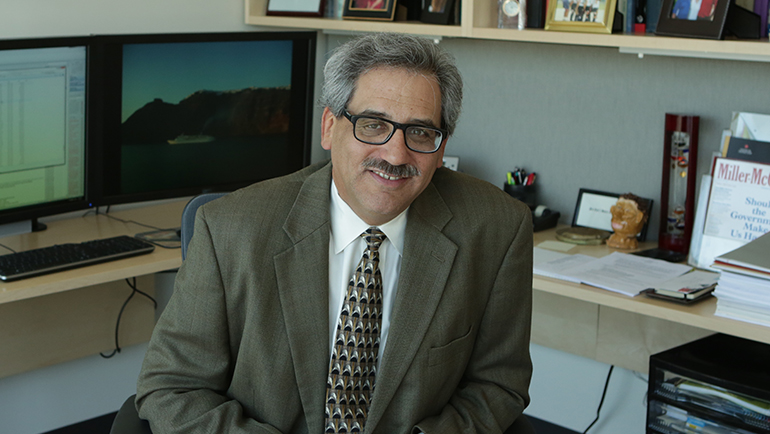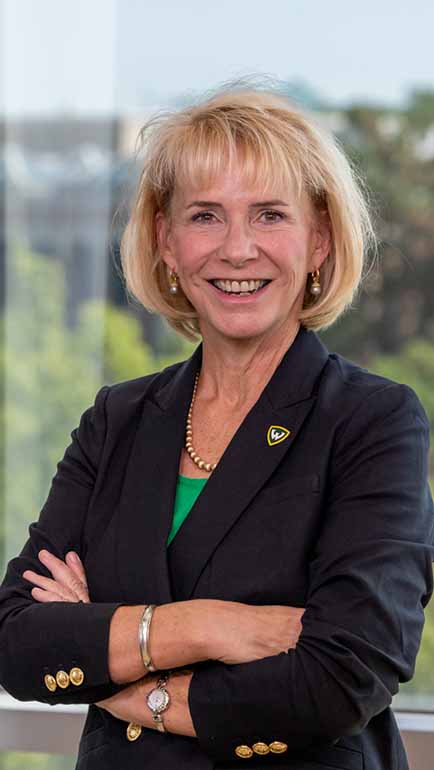
During the investiture ceremony for President Kimberly Andrews Espy, Ph.D., on March 18, her remarks will outline a vision for the university. One initiative already announced, College to Career, highlights how Wayne State students graduate career ready through cutting edge didactics and learning-by-doing experiences, such as research in the field, internships and mentoring.
Given her underscoring of the importance of mentorship, it is fitting President Espy will be introduced at her investiture by her mentor, Detroit native David J. Francis, Ph.D.
Francis grew up in East Detroit, now Eastpointe, where he attended St. Barnabas’ parish school and then Notre Dame High School when it was in Harper Woods. Today, he is the Hugh Roy and Lillie Cranz Cullen Distinguished University Chair of Quantitative Methods in the Department of Psychology at the University of Houston, where he also serves as director of the Texas Institute for Measurement, Evaluation, and Statistics (TIMES), as well as director of the Center for the Success of English Learners, a National Research and Development Center funded by the Institute of Education Sciences.

When President Espy completed her undergraduate work at Rice University, she was interested in studying the brain and resulting behavior. A friend of hers – the manager of the Rice University tennis team – arranged an introduction to Francis, who was a faculty member at the University of Houston, recent graduate of their Clinical Neuropsychology program and was a regular tennis player on the Rice courts.
That meeting in 1985 resulted in a relationship that has served them both well for many years.
“Kim was a graduate student in the neuropsychology program, and she was really interested in pediatric neuropsychology, which was an area that I did work in, but I primarily did work in measurement and statistics,” said Francis. “Kim was outstanding as a graduate student, and she really resonated towards statistical thinking and thinking logically with numbers. She was really good in the two-course sequence that I taught and she ended up becoming my TA for the statistics class. She was great as a TA. She’s really organized and was very supportive of the students.”
The two got along well and their interests aligned, so President Espy asked Francis to chair her thesis, and then her dissertation projects. In fact, he still has a copy of President Espy’s thick dissertation in his office.
“In addition to being incredibly competent and so inspiring, the amount of professional time that he devoted to mentor me to think computationally and in developing the skills needed to pursue my research interests was really unparalleled; he was so generous with his time and expertise. I draw on what I learned from him to this day” said President Espy.
The two went on to collaborate on several papers and a dozen presentations, most related to President Espy’s dissertation work on infants exposed to cocaine in utero.
Francis said, “I was doing a lot of work employing latent variable models and also employing growth curve models, and that was something that Kim was really interested in using in her work because of the interest in how babies who are exposed to cocaine develop and growth models are a way to look at development over time. That was something that we had in common in terms of interest in trying to address that issue statistically changing over time.”
In 2005, after learning that their research and the method they utilized in those papers was featured in a book Applied Longitudinal Data Analysis: Modeling Change and Event Occurrence, President Espy sent Francis a handwritten note telling him, “….it seemed the perfect time to thank you for your guidance, training and patience (!) along the way. You are an excellent teacher and mentor. I never could have come this far without your help.”
Of course, since then she has accomplished much more, and Francis has been watching from afar.
“To be the first female president at a university is just a real honor,” said Francis. “I wasn’t surprised to see that she had been named a president; I was really proud of her and really excited for her because I know she’s going to do a great job. In a lot of ways, the role of the president is to attract support to the university and get faculty moving in a commonly agreed upon direction for excellence. The president has a vision, and it’s got to be a shared vision. Then, the key is to be able to get people moving in that direction. I think Kim is going to be excellent at that. I think she is visionary.”
Francis said being asked to introduce President Espy at her investiture and being considered her mentor is an honor.
“To me as a faculty member, there’s no higher compliment than to say that this person mattered to me in terms of the way I think, the way I approach my job and the work that I do. That’s really the highest compliment to me.”
Students, faculty, staff, alumni and community members are invited to RSVP and attend this historic event at the Detroit Institute of Arts.
